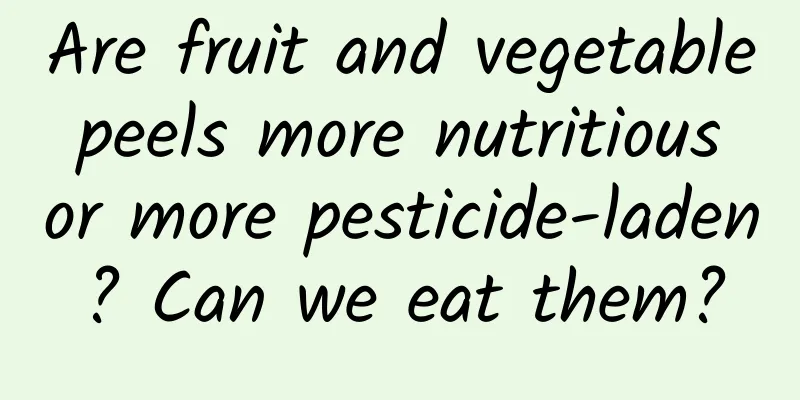Are fruit and vegetable peels more nutritious or more pesticide-laden? Can we eat them?

|
Are fruit and vegetable peels more nutritious or more pesticide-laden? Can we eat them? Change for health Zhongke physical examination 2023-11-03 10:00 Published in Jiangxi It is said that eating more fruits and vegetables is good for health, but eating fruits and vegetables can also make people confused: what to do with the peels, throw them away, or eat them? So who is right? Should we eat the peels of fruits and vegetables or throw them away? People who think it’s not worth losing: Half of the nutrition is in the skin Some people believe that fruit and vegetable peels have high nutritional value, half of the important nutrients in fruits and vegetables are in the skin, and they even have many benefits to the human body. What is the truth? From the analysis of nutritional components, fruit and vegetable peels do contain a lot of vitamins, minerals and plant active ingredients. If compared by unit weight, they are indeed higher than the flesh. Taking apples as an example, someone has measured the flavonoid content in the peels and flesh of 8 kinds of apples. The results show that the flavonoids in the flesh are 15.0~605.6mg/kg, and the flavonoids in the peel are 834.2~2000.3mg/kg. In addition, half of the dietary fiber in apples is in the skin. If you don’t eat the skin of a 250g apple, you will get about 3g less dietary fiber. We usually only eat about 13g of dietary fiber a day, and less than 5% of people can reach the appropriate intake of 25g. Similarly, the anthocyanin content of grape skin is also higher than that of the flesh, and the mineral potassium in sweet potato skin and potato skin is also not small. So, does this mean that the skin is really valuable? Not necessarily! There is only a little bit of apple skin, and the amount of nutrients taken in by eating apple skin is very small, which has no significant effect on health. Grape skin is rich in cellulose, pectin, and iron, which can help beautify the skin. In addition, grapes are rich in polyphenols, which can play a certain antioxidant role and assist in cardiovascular protection. Its content in grape pulp is about 3%~5%, in grape seeds is about 60%~70%, and in grape skin is about 20%~30%. It can be seen that the nutrition of the skin is still relatively high. Eating fruits and vegetables with the skin on also poses certain risks, the most common of which is pathogenic microorganisms. Fruits and vegetables may be contaminated with many invisible bacteria during long-distance transportation and storage, but as long as they are washed carefully, most of them will generally be washed away. In general, we don’t need to be obsessed with the exaggerated nutritional value of fruit and vegetable peels and deliberately eat them. If you think it’s a pity to throw away the peels, then eat them. People who think it should be thrown away: There are pesticide residues, so don't eat it. In recent years, there have been more and more reports on food safety, and many people have deep concerns about the food production environment. Do fruit and vegetable peels really have pesticide residues? Legally, my country has explicitly banned the use of highly toxic pesticides in fruits and vegetables and other foods that are eaten directly, and has strictly regulated the dosage of pesticide residues in food. Pesticide residues in fruit and vegetable peels may not be high. A previous research report tested pesticide residues in 200 apple samples on the market, and only 0.5% of the samples exceeded the standard. Generally speaking, the pesticide residues in most fruits and vegetables we eat are lower than the national standard, so there is no need to worry too much about pesticide residues. However, for some fruits and vegetables, peeling is indeed a safer choice. It is recommended to peel root fruits and vegetables, and to wash leafy vegetables and some fruits (such as grapes) with safe water. In fact, as long as the national standards are followed, the pesticide residues of fruits and vegetables purchased from regular shopping malls and supermarkets are controlled within the safe range. In summary, as long as you wash carefully, you don't need to worry too much about the danger. If you are worried about pesticide residues, you can put a small amount of baking soda in water, then soak the fruits and vegetables in it for 5 to 10 minutes, and finally wash them with running water. Baking soda is an alkaline substance, while most pesticides are acidic. The two can react with each other, thereby promoting the rapid decomposition of pesticide residues. |
<<: Understand dental bacteria and protect your oral health
Recommend
What are the health and beauty tips for women
Women are a vulnerable group and, judging from th...
Will tea go bad at high temperatures? How can tea be stored for many years without going bad?
With the improvement of living standards, more an...
Things to note before cervical biopsy
Cervical biopsy is a common medical method. This ...
What does a purple sweet potato look like when it's bad? Is it ok to eat a purple sweet potato with white spots inside?
Purple sweet potatoes are the same as the sweet p...
What are the effects of the "slimming essential oil" popular in the weight loss circle?
Many people who want to lose weight have heard of...
How much does cervical repair surgery cost?
Cervical erosion is also a very common gynecologi...
Pregnant women's blood sugar is low one hour later
After becoming pregnant, women may need to check ...
What is the cause of amenorrhea in girls?
Girls can also experience amenorrhea. Many people...
How mature is the follicle?
Conceiving life is a magical thing. Pregnancy can...
What to do if the placenta is close to the cervix
There are many issues that need attention during ...
What are the symptoms of vulvar itching caused by Trichomonas vaginitis?
Trichomonas vaginitis is a common gynecological d...
What to do if leucorrhea is like water
Healthy leucorrhea is a precious asset possessed ...
Can I exercise during my period?
For female friends, the monthly menstrual period ...
Ordinary women don't drink tea, women who drink tea are not ordinary
There are two classic sayings about women and tea...
How to clean octopus? How to eat octopus?
Octopus is rich in nutrients and can promote the d...









